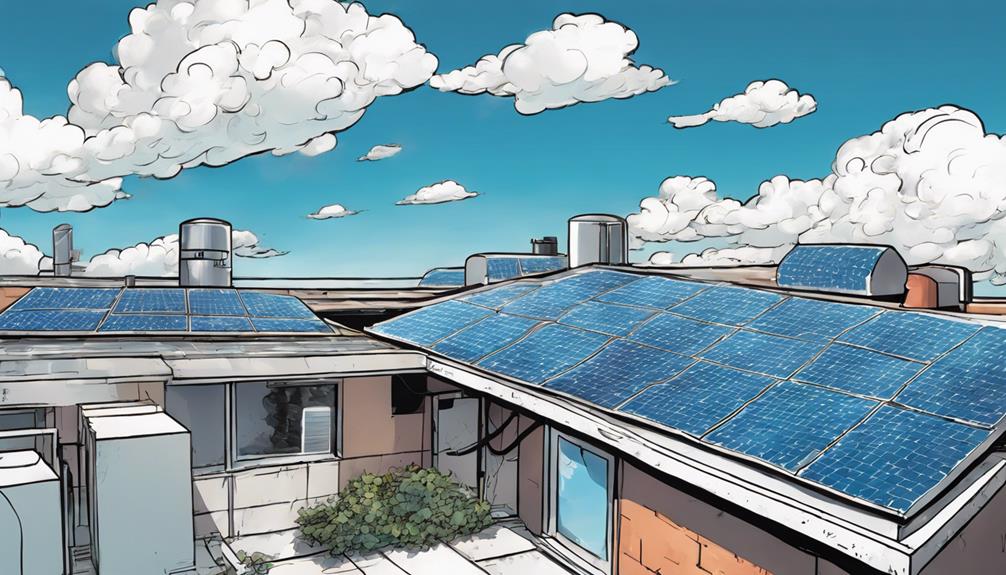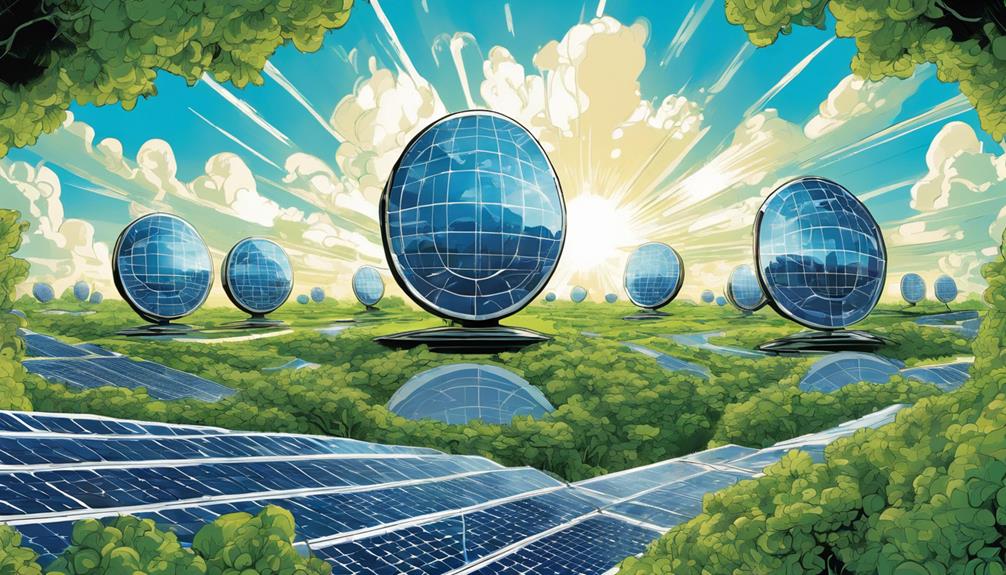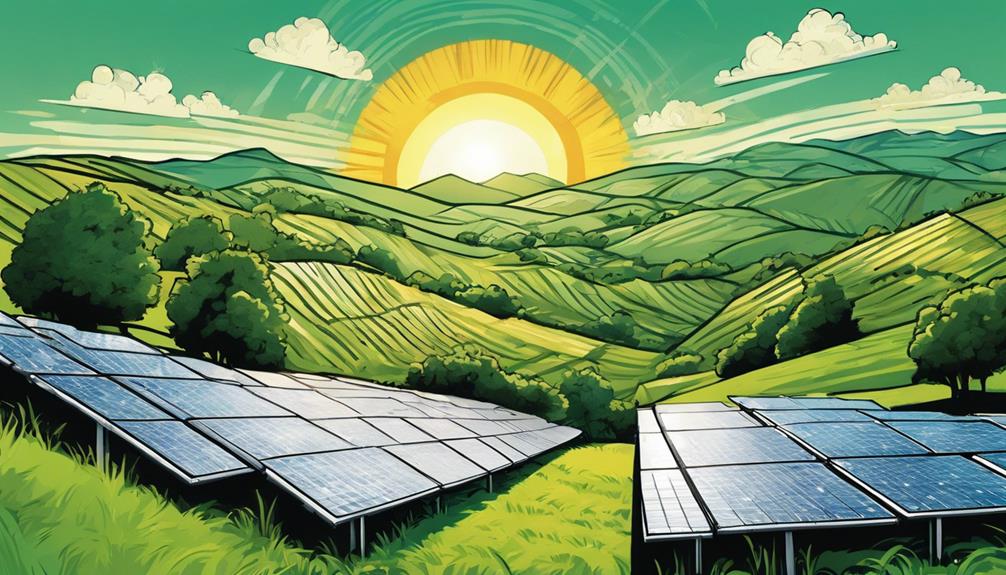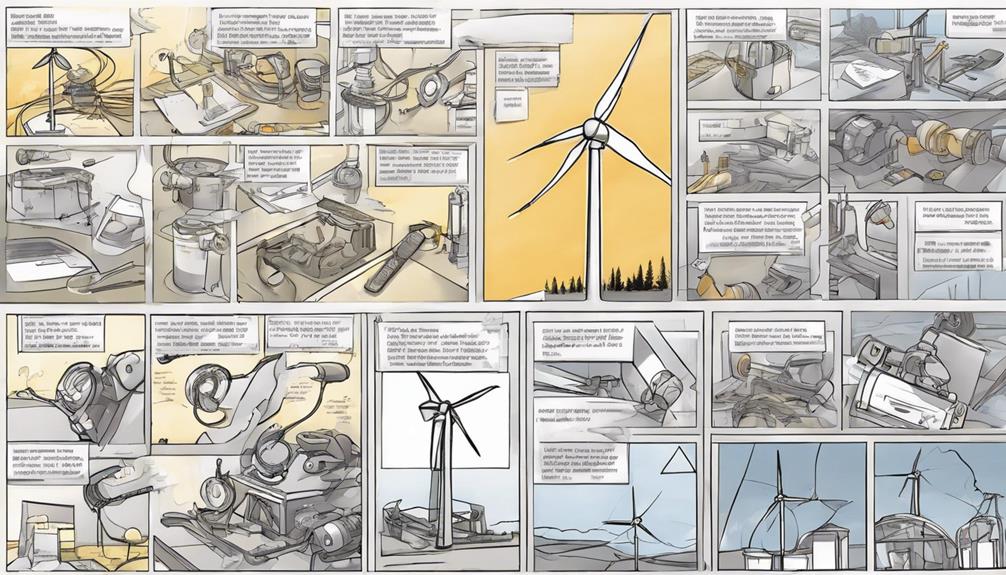As I explore the world of solar energy, I'm amazed by the diverse range of innovative technologies that harness the sun's power. From passive design elements like strategic window placement to active systems using mechanical components, there's a solution for everyone. I've learned that maximizing sunlight exposure can boost energy production by up to 40%, and photovoltaic technology offers a clean and efficient way to generate power. Whether it's for heating homes, powering commercial buildings, or achieving energy independence, there's a solar energy application that suits my needs. Now, I'm excited to dive deeper and discover which technology is the best fit for me.
Key Takeaways
- Passive solar design elements, like strategic window placement and insulation, can create a warm and inviting living space without mechanical devices.
- Active solar energy systems harness the sun's power using mechanical and electrical components to generate electricity and heat.
- Effective sunlight harnessing, considering time of day, season, and location, can increase energy production by up to 40% and reduce energy expenses.
- Photovoltaic technology converts sunlight directly into electricity, offering a clean and efficient means of generating power without moving parts.
- Solar energy applications range from heating and cooling homes to powering commercial buildings, providing energy independence and environmental benefits.
Passive Solar Energy Principles

By incorporating thoughtful design elements, such as strategically placed windows, insulation, and thermal mass materials, I can harness the sun's natural heat and light to create a warm and inviting living space. This approach, known as passive solar energy, maximizes the sun's energy without relying on mechanical devices.
Active Solar Energy Systems

I'm shifting my focus to active solar energy systems, which harness the sun's power using mechanical and electrical components to generate electricity and heat.
Unlike passive solar energy, active systems require active involvement for energy generation. Solar panels, made up of solar cells, convert sunlight into electricity. Inverters then convert the DC power into AC, making it usable for household appliances.
These systems can power appliances directly or store excess energy for later use. Active solar energy systems offer a reliable and efficient way to reduce reliance on non-renewable energy sources.
With proper installation and maintenance, they can provide long-term cost savings and environmental benefits.
Harnessing Sunlight Effectively

As I explore the realm of solar energy, I've come to realize that effectively utilizing sunlight is key to maximizing energy production. To optimize energy production, positioning solar panels at the ideal angle and orientation to capture direct sunlight is essential, as even slight deviations can greatly impact overall efficiency.
This means considering factors like the time of day, season, and geographical location to guarantee maximum energy harvesting.
Here are three reasons why proper sunlight harnessing is a game-changer:
- Enhanced energy output: Direct sunlight exposure can increase energy production by up to 40%.
- Decreased carbon footprint: By maximizing energy output, we can reduce our dependence on non-renewable energy sources.
- Reduced energy bills: Effective sunlight harnessing results in significant cost savings on energy expenses.
Photovoltaic Technology Advantages

Converting sunlight directly into electricity, photovoltaic technology offers a clean and efficient means of generating power, with its numerous advantages making it an attractive option for those seeking a sustainable energy solution.
As I explore further into this technology, I'm impressed by its ability to produce electricity without moving parts, reducing maintenance costs and increasing its lifespan. Additionally, photovoltaic technology can be scaled up or down depending on energy needs, making it suitable for both residential and commercial applications.
With ongoing advancements, its efficiency is continually improving, allowing it to become an increasingly viable alternative to traditional energy sources. Overall, photovoltaic technology's advantages make it an excellent choice for those looking to reduce their carbon footprint and energy bills.
Solar Energy Applications

From heating and cooling homes to powering commercial buildings, solar energy applications are diverse and widespread, offering a range of benefits that make them an attractive alternative to traditional energy sources.
As I explore the various uses of solar energy, I'm struck by the potential to transform our daily lives.
Here are just a few examples that get me excited:
- 1. Energy independence: Solar energy systems can power my home, reducing my reliance on the grid and saving me money on electricity bills.
- 2. Environmental benefits: By harnessing renewable energy, I can substantially reduce my carbon footprint and contribute to a sustainable future.
- 3. Long-term cost savings: With solar energy, I can enjoy lower energy costs for years to come, making it a smart investment for my home and business.
Frequently Asked Questions
How Does Solar Energy Storage Work During Prolonged Periods of Cloudiness?
"When I'm worried about prolonged cloudiness, I rely on energy storage systems like batteries to store excess energy generated during sunny days, ensuring a continuous power supply even when the sun's not shining."
Are Solar Panels Resistant to Extreme Weather Conditions Like Hurricanes?
"While hurricanes wreak havoc, I'm relieved to know solar panels are built to withstand extreme weather conditions, with robust frames and tempered glass, ensuring my renewable energy source remains resilient in the face of fury."
Can I Install Solar Panels on My Old or Historic Home?
'Yes, I can install solar panels on my old or historic home, but it's important to verify the structural integrity of my roof and comply with local preservation regulations to avoid any potential issues.'
How Often Do Solar Panels Need to Be Cleaned and Maintained?
'I typically clean my solar panels every 6-12 months, depending on the climate and debris buildup. Regular maintenance is important to guarantee the best energy output and prolong their lifespan.'
Are There Any Government Incentives for Installing Solar Energy Systems?
'Catching coveted credits, I'm thrilled to share that yes, there are government incentives for installing solar energy systems. Federal and state tax credits, rebates, and grants can greatly offset the upfront costs, making solar more accessible and affordable.'
How can the daily energy production of a solar power plant impact the choice of solar energy technologies for individual use?
The daily energy production of a solar power plant can influence the choice of solar energy technologies for individual use. If the solar power plant’s energy production is high, it may indicate that the area has good solar resources, making it a viable option for individuals to invest in solar energy technologies for their own use.
What Types of Solar Energy Technologies Are Best Suited for Residential Use?
When it comes to harnessing the power of solar energy for residential use, certain technologies stand out. Photovoltaic (PV) panels are a popular choice for converting sunlight into electricity, while solar water heating systems are efficient for supplying hot water. Both options offer reliable and sustainable energy solutions for homeowners.
How Can Sunlight Affect the Efficiency of Different Solar Energy Technologies?
Different solar energy technologies are heavily reliant on vital sunlight for solar panel. Photovoltaic cells convert sunlight into electricity, while solar thermal systems use sunlight to heat a fluid that produces steam to drive a turbine. The intensity and duration of sunlight directly impact the efficiency and output of these technologies.
What Are the Different Solar Energy Technologies That Are Game Changers for Sustainability?
There are several innovative solar energy sustainability game changer technologies making a significant impact. Floating solar panels, solar skin technology, and concentrated solar power systems are just a few examples. These advancements are revolutionizing the way we harness solar energy and are crucial for achieving long-term sustainability goals.
Conclusion
As I conclude my journey through the domain of solar energy technologies, I'm reminded that 'knowledge is power.'
With a deeper understanding of passive and active solar energy, I'm empowered to make informed decisions about which technology suits my unique needs and goals.
By embracing solar energy, I'm not only reducing my carbon footprint but also taking a step towards a brighter, more sustainable future.










